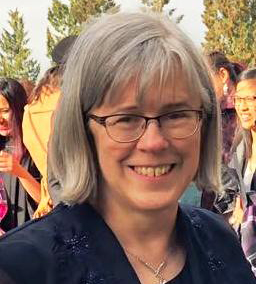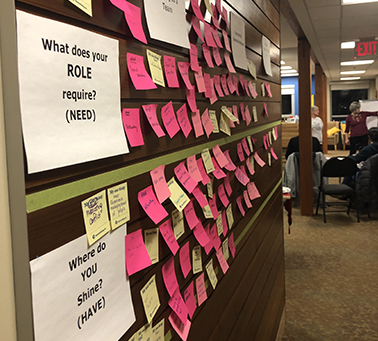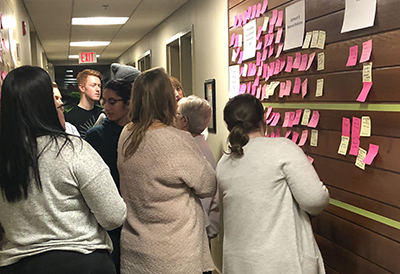Skills Mapping: A New Approach To Stronger Teams

Many of us know the joys and challenges of working with teams. Teams of volunteers (committees, boards, etc.) are not exempt from these and additionally face unique nuances and realities. Because organizations must always focus on the successful development of people and programs, this presents a number of training opportunities, no matter if you work with new or seasoned groups.
The particular team that helped inspire this Training Design is a committee with many long-term, dedicated volunteers who plan a Canadian Cancer Society Relay for Life event which raises between $350,000 and $600,000 in Canadian dollars each year. Over the past year, the staff partner (employee), event chair (volunteer), and myself have begun exploring how to create a legacy for this successful, long-term event that is sustainable in the future, rather than one which rests solely on the shoulders of the existing volunteers.
Change and transition are inevitable, and this can leave a committee vulnerable when volunteers retire (especially if they have unique skill sets). It’s recognized that in any group, no matter how diverse, there are likely ‘thin’ areas where we need to focus on additional recruitment or transition. It’s also critical to provide a mechanism for a team to recognise its own vulnerabilities so that members can be equipped to support new recruitment and be welcoming to new people and new skills as they join the team.
With all this in mind, welcome to Skills Mapping, something new to build strong teams and sustain committees.
Anticipated Outcomes of Skills Mapping
The overall purpose of this Training Design is to introduce Skills Mapping and to develop a committee by affirming the committee's strengths and identifying gaps or areas of vulnerability if current committee members were to leave or change roles. To drill down a little further, we identified both personal and organizational outcomes we hoped to achieve:
- Identify skills that are important for the committee’s past success (especially ones we might not have considered);
- Provide space for the committee to understand and acknowledge where they could welcome new members with different skills;
- Discuss the composition and functioning of the team;
- Allow for proactive planning for training, support, or additional recruitment;
- Support individuals in their personal self-awareness and personal development.
This would be accomplished by working as a group to create a collective map of existing skills and to identify those skills needed for committee positions and continued event success. Each group will have a different response and derive different outcomes from this type of session. You may even have a different purpose than we did for delivering this workshop. And that’s OK!
Developing the Workshop
We first identified specific skills, competencies, and personal attributes in several relevant areas:
- Mission Knowledge & Vision
- Communication, Relationships & Working as a Team
- Planning & Logistics
- Outreach & External Relations
- Analytical & Technological Skills
We included concrete skills and experience (knowledge of mission, programs, and services) as well as ‘soft’ competencies (open to continuous learning, joy in seeing others succeed). We encouraged people to add skills that were not on our list. Depending on your organization, the goals and outcomes desired and the group you’re working with, you may come up with different items or even different sections.
We were sensitive to the vulnerability that can be created through a public analysis, or the blame that can be attached to focusing on gaps. Therefore, we chose to use an appreciative inquiry format in order to focus on identifying possibilities for growth.
We wanted the session itself to be highly interactive. Within the workshop, we walked participants through a process (involving countless post-its) of identifying their own skills and what their volunteer role requires (see workshop outline below). The straightforward idea was to look at what we need (i.e. the role requirements) and what we have (individual competencies) in order to discern gaps and strengths so that we could plan, recruit, and/or provide training.
Here is a more detailed review of competencies, skills, and personal attributes.
Pre-Work for Participants
To make the most of our training time together, we asked each person in advance to complete a reflective assessment of themselves, their volunteer role, and the functioning of the committee. We estimated that the pre-work would take approximately 20 minutes.
Workshop Outline & Timing
Bridge (What’s in it For Me?): 5 minutes
- Articulating the benefits for participants and the committee as a whole
Introductions: 10 minutes:
- Set the positive tone and expectations.
- Participants were asked to identify ‘My top skill’ (we called this their ‘superpower’) and a ‘bouquet’ for the group – i.e., something the group does well together.
Mini-Lecture: 5 minutes
- Importance of a rounded committee; skills for the specific roles and competencies for working within a group; outline our direction for the session and outcomes.
Activity – What does your role require?: 8 mins
- If you were recruiting someone new to take your position, what are the skills they would need? Take 5 – 10 pink post-its and write the top skills your role needs. Put ONE skill per post-it (very important!).
- Put post-its on the wall in the matching category (a sign on the wall indicated the various categories e.g. Mission Knowledge).
Activity – Where you shine?: 7 mins
- Take up to 10 yellow post-its and write the top skills you bring. Put ONE skill per post-it (very important!). Put it in the area for that type of skill, below the need section.
Reflective Activity – Observing the Skills Map: 5 minutes
- Take a few minutes to silently look at the map. What do you notice? What skills do we share? Are there obvious areas where we are thin?
Small Group Discussion – Sharing Observations: 10 mins
- Break into groups of 3 – 4 to discuss the skills map and share your observations.
- Report back to the larger group briefly with one observation or idea.
Break: 5 minutes
Reflective Activity – What do you want more of?: 5 minutes
- Where do you want to develop personally OR as a group? Or perhaps you’ve identified new competencies we could add to the group’s skill set.
- Take 3 – 5 green post-its. Put one idea per post-it and put them on the wall in the corresponding section (below the ‘have’ post-its).
- The committee can use this information to consider group training or recruitment.
Small Group Discussion – What Could the Future Look Like?: 10 minutes
- Refer to your pre-work on question 4. Thinking about your answers to 4 b & c, (thin spots or new skills you identified about for the committee) discuss the following questions:
- If we could recruit one person to the committee to bring a new perspective and/ or new skills, what would that look like?
- What is our ideal future state as a committee?
- What can we change?
Large Group Sharing & The Way Forward: 15 minutes
- Share personal and small group insights
- Identify items for further action and exploration
- Anything to add to the “More” category?
Post-Assessment & Wrap: 5 minutes
- Popcorn: key concepts/ things you’ve learned today
- Share “More” post-its
- Handout evaluation form
- Thank you for coming
TOTAL: 90 minutes
 An important note: Following the workshop, we made a few adjustments to enhance the flow of future workshops, especially in the second half. The participants took time to become comfortable and the workshop became much more engaging when people started interacting in small groups, so the time for discussions was extended and the break was moved to after the first discussion so that the dialogue would spill over into the informal break time. A section for the ‘way forward’ was added to ensure that groups identified some action items to work on post-workshop.
An important note: Following the workshop, we made a few adjustments to enhance the flow of future workshops, especially in the second half. The participants took time to become comfortable and the workshop became much more engaging when people started interacting in small groups, so the time for discussions was extended and the break was moved to after the first discussion so that the dialogue would spill over into the informal break time. A section for the ‘way forward’ was added to ensure that groups identified some action items to work on post-workshop.
Additionally, we recognized that committees have a tendency to start out or become homogenous, so we added a more focused question on recruitment and diversity to spur thinking beyond the demographics, experiences, and skill set of the people in the room. We added the question to the “Small Group Discussion” section: If we could recruit one person to the committee to bring a new perspective and/ or new skills, what would that look like?
Post-Event Follow-Up
We plan to follow up by gathering information from absentee members and providing a visual skills map as a record of the session.
Tips for Success:
- Workshops of this type are only as successful as the group is willing to engage and invest in them. Ensure that the group has full buy-in to the process before going ahead.
- Be aware that people checking email on their phone may have trouble opening documents and not everyone has a printer, so providing a paper copy of the pre-work is helpful.
- People are notoriously poor at finishing advance activities. Hand the pre-work out at a meeting prior to the workshop and allow a few minutes to absorb and ask questions, or even set time aside at a regular meeting to do the pre-work. You could also set up a special time by teleconference, webinar etc. to walk through the activity and encourage completion if you have a remote group or it is difficult to make time during a meeting.
- Involve a skilled facilitator who can keep the group on task and on time.
- Set and maintain a positive tone to keep focused on possibilities. If needed, set group agreements before starting and ensure that they are maintained.
- This workshop would work best in a large meeting area because of the post-it activity. Make sure to allow plenty of space for the post-its so that the whole group has space to stand in front of the display and easily circulate. For example, allow 6 feet or more in between each category (I used two sides of a hallway and that was far too congested).
 Adapting the Workshop
Adapting the Workshop
- The workshop is very tightly timed. If you have a talkative group, a group unfamiliar with this type of workshop, a larger team or even a newly-formed team, consider adding more time – perhaps two hours for a more contemplative pace and more time for interaction.
- Groups may benefit from a fun interactive group icebreaker to open the workshop; the comfort level and engagement of groups tends to rise dramatically once participants start small-group interactions.
- Adjust the skills and categories so that they are relevant for your team.
- Consider focusing only on either skills or competencies (rather than both) depending on the needs of your group.
- Reduce or adapt pre-work depending on your group’s needs and capacity.
- People enjoyed the coloured post-its. You could consider having different colours for important vs. critical skills.
- Develop probing discussion questions that reflect the needs of your group.
- Introduce an accountability/action step section and assign actions at the end if that is helpful for your group. The workshop could easily be extended and supplemented with more group discussion and planning around specific items that were raised, recruitment strategies for the group to adopt, etc.
Feedback from Participants
The workshop was very successful and it elicited unexpected insights about how the committee interacted with and supported each other. The level of comfort that the group attained during the session was impressive; they came to the session with strong existing relationships, and engaged with the material in a creative way and with great honesty.
We solicited comments through a seven-question workshop evaluation. One of the key leadership volunteers, the event Co-Chair, commented that the “workshop was a positive experience for us to celebrate our individual and collective skill strengths while evaluating the benefits and value of these skills within our team. I had an opportunity to participate in highlighting and celebrating the strengths of our dedicated volunteers while providing a safe environment for conversation to identify needs and opportunities for team growth for our volunteer leaders.”
Perhaps my favourite comment from the evaluations? “Based on this session alone, there will be tremendous opportunity for growth (personally).” Given that we want volunteers to experience leadership roles both as a way to give and as an opportunity for development, this was a powerful example of stewardship in action.
Conclusion
Working with teams and helping them thrive is a never-ending job. In the end, however, the effort pays untold dividends. With today's volunteers tending to make shorter commitments, it’s inevitable that there will be regular turnover of members. This reality makes workshops and Training Designs like this even more valuable to help teams get on the same page and work together quickly and cohesively.
Good luck with your Skills Mapping!


Tracey O'Neill | Austin Health | Melbourne, VIC, Australia
Mon, 12/16/2019Nancy Shelford, Canadian Cancer Society
Fri, 01/03/2020